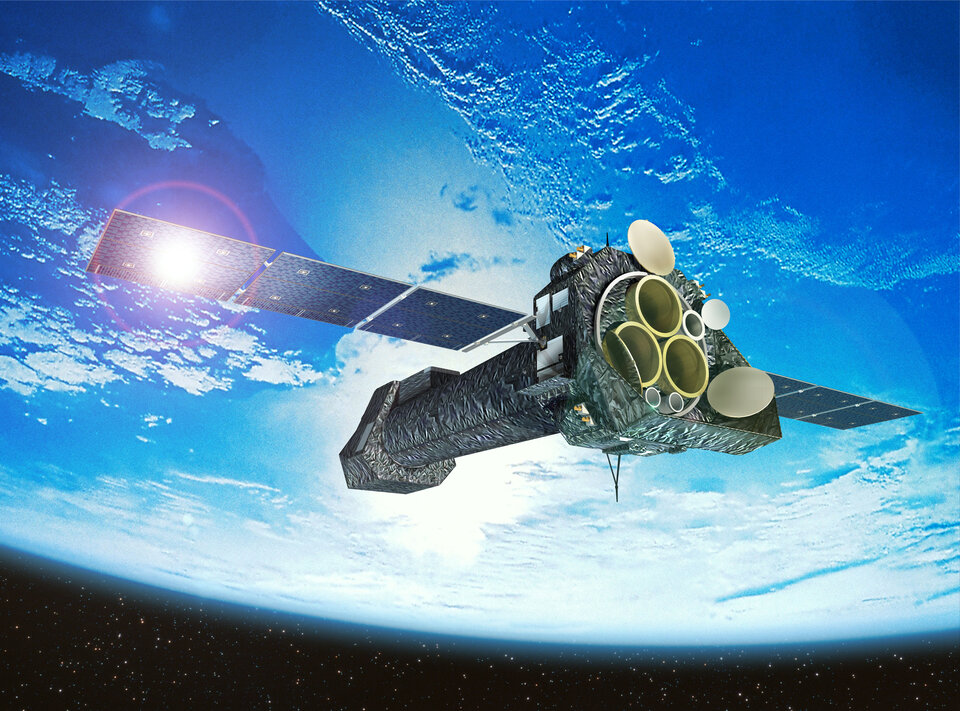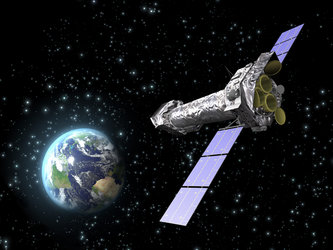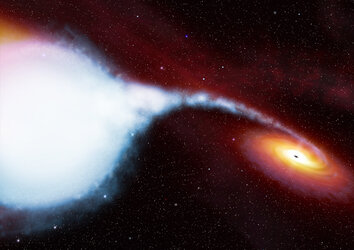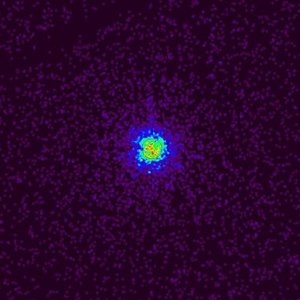XMM-Newton
Objective
Increasing our knowledge of very hot objects created when the Universe was very young, XMM-Newton will help solve many mysteries, ranging from black holes to the formation of galaxies.

http://www.esa.int/science/xmmnewton (Ctrl+D)
For more in-depth scientific and technical details of our Space Science Programme and missions, follow this link.
Mission

XMM-Newton is detecting more X-ray sources than any previous satellite and is helping to solve many cosmic mysteries of the violent Universe, from what happens in and around black holes to the formation of galaxies in the early Universe. It is designed and built to return data for at least a decade.
It is the biggest science satellite ever built in Europe. Its telescope mirrors are the most sensitive ever developed in the world, and with its sensitive detectors, it sees much more than any previous X-ray satellite.
XMM-Newton’s high-technology design uses over 170 wafer-thin cylindrical mirrors spread over three telescopes. Its orbit takes it almost a third of the way to the Moon, so that astronomers can enjoy long, uninterrupted views of celestial objects.
What's special?
XMM-Newton has been able to measure for the first time the influence of the gravitational field of a neutron star on the light it emits. This measurement provides much better insight into these objects.
Neutron stars are among the densest objects in the Universe — a sugarcube-sized piece of a neutron star would weigh over a thousand million tonnes. Neutron stars are the remnants of heavy stars that end their life in a supernova explosion. In such cataclysmic events, most of the stellar matter is ejected into space (to eventually become the building blocks of all matter in the Universe, including ourselves). Part of what remains then collapses under its own gravity.
Scientists believe that, in a neutron star, the density and the temperatures are similar to those existing a fraction of a second after the Big Bang when the primordial soup of matter in the Universe was ‘broken’ into its most fundamental constituents. They assume that when matter is tightly packed as it is in a neutron star, it goes through important changes. Protons, electrons, and neutrons — the components of atoms — fuse together. It is possible that even the building blocks of protons and neutrons, the so-called quarks, get crushed together.
Scientists have spent the last decades trying to identify the nature of matter in neutron stars. To do this, they need to know some important parameters, very precisely. If you know a star’s mass and radius, or the relationship between them, you can obtain its density. However, no instrument was advanced enough to perform the measurements needed, until now. Thanks to ESA’s XMM-Newton observatory, astronomers have been able to obtain the mass-to-radius ratio of a neutron star for the first time and acquire the first clues about its composition. These clues suggest that neutron stars contain normal, non-exotic matter, although they are not conclusive. Scientists say this is a ‘key first step’ and that they will keep on with the search.
This measurement was a first in astronomical observation and it is considered a huge achievement. The method consists of determining the compactness of the neutron star in an indirect way. The gravitational pull of a neutron star is immense — thousands of million times stronger than the Earth’s. This makes the light emitted by the neutron star lose energy. This energy loss is called a gravitational ‘redshift’. The measurement of this redshift by XMM-Newton indicated the strength of the gravitational pull, and revealed the star’s compactness.
Spacecraft
XMM-Newton's name comes from the design of its mirrors, the highly nested X-ray Multi-Mirrors. These are enabling astronomers to discover more X-ray sources than with any of the previous space observatories. In one day, XMM-Newton sees more sources in a small area than one of the earliest X-ray satellites UHURU found across the whole sky during its three years in operation.
However, the programme also has a more formal name: the High-Throughput X-ray Spectroscopy Mission. Spectroscopy, the spreading of light into a spectrum, allows astronomers to measure a source’s composition. In the same way the colour of a lamp indicates what gas is used in street lighting, the three scientific instruments on board XMM-Newton will reveal the deepest secrets of a source, its chemical composition, temperature, and even the velocity of the source.
XMM-Newton can change its orientation extremely precisely using two sets of four small thrusters that use hydrazine gas and four momentum wheels mounted on the spacecraft are the primary means to control its attitude. It builds on the system which previously flew on the ISO mission, and is now also in use on the Integral mission.
Journey
XMM-Newton, in its 48-hour orbit, travels to nearly one third of the distance to the Moon. At the apogee (furthest point) of 114 000 kilometres away from Earth, the satellite travels very slowly. At the perigee (closest point) it passes 7000 kilometres above Earth much faster at 24 120 kilometres per hour. XMM-Newton’s highly eccentric orbit has been chosen so that its instruments can work outside the radiation belts surrounding the Earth.
The orientation of a satellite in space is crucial, whether for telecommunications, Earth observation or for astronomy missions. XMM-Newton will be targeting distant X-ray sources for long periods (often more than ten hours) and one of the key requirements of the satellite is its very high pointing accuracy and stability.
While orbiting the Earth in its highly elliptical orbit, XMM-Newton is steered to point its telescope towards targets selected by astronomers. The 3.8-tonne satellite slowly turns towards these celestial objects at a rate of 90 degrees per hour.
The pointing accuracy of the 10-metre long XMM-Newton is 0.25 arcsec over a 10-second interval. This is the equivalent of seeing a melon from a distance of 300 kilometres, using a handheld telescope and seeing it without the slightest wobble!
History
Before the late 1970s, only four galaxies had been detected emitting X-rays: the Milky Way, M31, and the Magellanic Clouds. Building on earlier work in the field, ESA’s X-ray observatory, Exosat, was launched in May 1983. It was active until April 1986, by which time it had made 1780 X-ray observations.
In 1982, an ‘X-ray Multi-Mirror’ astronomy mission was proposed. In 1984, a group of European scientists developed the ‘Horizon 2000’ long-term plan for ESA’s scientific programme. The idea was to achieve a 50% increase in the annual science budget over the following five years. Central to this plan was the concept of four ‘Cornerstones’ — large-scale missions whose scientific objectives would be achievable. The second Cornerstone was to be a ‘High Throughput X-ray Spectroscopy’ mission, or XMM by another name.
Serious work on XMM started in 1985 with the establishment of a number of working groups. The overall configuration was developed by 1987, looking very much like XMM as we know it today. Following the experience with Exosat, which demonstrated the value of a highly eccentric orbit for long uninterrupted observations of X-ray sources, XMM was to be placed in a 48-hour period orbit using the Ariane 4 launcher. The payload now featured only four X-ray mirror systems. However a very important feature had been added — the Optical Monitor — an instrument to allow simultaneous observation of the field of view the X-ray telescopes in the UV and visible bands. This was a lesson learned from the operation and exploitation of Exosat. An important part of XMM-Newton is that all instruments work in parallel — this is an extremely important tool in making the observatory more efficient.
ESA approved the mission in this form in June 1998. One year later the selection of the instruments and the long hardware development programme began. The Survey Science Centre was selected by ESA in 1995 to develop the processing of the XMM data.
XMM-Newton launched at the end of 1999.
Partnerships
The instruments have been conceived and built by European scientific institutes, and are each managed by a Principal Investigator (PI), heading teams of scientists and engineers from different countries. Overseeing the science of the entire mission is ESA’s XMM-Newton Project Scientist.















 Germany
Germany
 Austria
Austria
 Belgium
Belgium
 Denmark
Denmark
 Spain
Spain
 Estonia
Estonia
 Finland
Finland
 France
France
 Greece
Greece
 Hungary
Hungary
 Ireland
Ireland
 Italy
Italy
 Luxembourg
Luxembourg
 Norway
Norway
 The Netherlands
The Netherlands
 Poland
Poland
 Portugal
Portugal
 Czechia
Czechia
 Romania
Romania
 United Kingdom
United Kingdom
 Slovenia
Slovenia
 Sweden
Sweden
 Switzerland
Switzerland
































